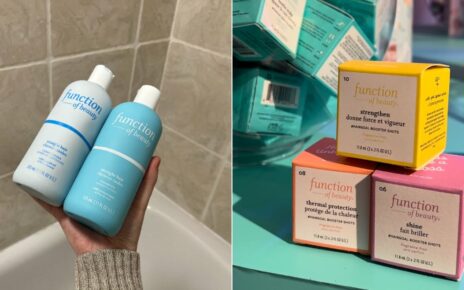Written by Daisy Bradbury
Gua sha can help with bloating, energy levels and tiredness.
We’re all accustomed to aches and pains, whether it’s the twang of lower back strain from sitting at a desk all day or tech neck induced from hours working at the kitchen table. While a professional massage can work wonders, finding time in our busy schedules means that stretching, foam rolling and figuring out why that bit hurts, often slips to the bottom of the priority list.
So, when I heard that gua sha (the muscle scraping method rooted in traditional Chinese medicine) could promote improved circulation, aid lymphatic drainage, relieve muscle tension and reduce water retention, I was immediately interested. Here’s what happened when I put it to the test for a month.
What is gua sha?
Gua sha is a therapeutic healing technique from traditional Chinese medicine which has been used on the face and body for centuries. It involves using a round-edged tool to firmly scrape the skin, balancing the body’s qi (or ‘vital energy’). A Qi deficiency can lead to fatigue and bloating, whereas excessive qi causes irritability and stress, so regulating this is important.
Gua sha is widely known as a lymphatic drainage massage, helping the lymphatic system work more effectively by stimulating the fascia: the connective tissue surrounding muscles, nerves and veins. The practice also improves blood circulation and helps clear toxins from the body.
I incorporated gua sha into my nightly relaxation routine, applying a generous amount of body butter and using my rose quartz tool to massage my body section at a time for ten minutes.
The key is to apply quite a bit of pressure – it should be firm, but not painful, to really work. It’s also important to repeat each stroke seven to eight times before changing position so you can penetrate those deeper knots.
What are the benefits of gua sha?
Gua sha isn’t only a way to achieve reduce water retention or ‘de-puff’; it’s an overall wellness technique.
1. It can help with energy levels
According to Ada Ooi, TCM facialist and founder of 001 Skincare, “gua sha enhances our mitochondria ability, also known as the ability to take food and turn them into energy within our cells for us to maintain well and remain functional.” It’s no wonder I felt fighting fit and full of energy.
2. It can improve feelings of sluggishness and bloat
These massages also prevent physical illness and lethargy. Ruby Speight, a massage and lymphatic drainage therapist, explained why: “A stagnated lymphatic system can result in a weakened immune system, leaving us prone to feeling run down.”
After a hectic month of deadlines and travelling (which would normally cause me to get sick), I surprisingly managed to dodge any illness – something I should perhaps owe to this technique.
3. Muscle relaxation
Relaxed muscles are another benefit of gua sha, as the scraping helps to release knots in muscle fibres by loosening the fascia. After doing multiple long-haul flights where my body was cramped into uncomfortable positions for hours, the gua sha certainly helped to ease some of this discomfort.
4. Reduces water retention and inflammation
Gua sha also drains excess fluid from the body, reducing inflammation and water retention. While I didn’t see any physical evidence of this, I definitely felt less sluggish and bloated.
What can’t gua sha do?
One of the biggest misconceptions (often dispersed online) is that gua sha can help you lose fat or excess weight. Ooi explains why this isn’t true: “Because gua sha can unknot muscle tension and promote drainage of unwanted stagnated fluids, it helps to reduce swelling and can make you feel lighter in your body.”
Weight loss and fat loss are only beneficial goals when achieved in a healthy way. No tool or “hack” will accomplish this. Instead, quality sleep, stress management, regular movement, a balanced diet and, crucially, having some fun, are far better goals to aim for.
Similarly, the popular untruth (again, often spread online) about using a gua sha for cellulite reduction does much more harm than good. Cellulite is determined by hormones, genetic factors, as well as the structure in which fat cells sit underneath the skin. Using a gua sha will not change these factors.
What should I know before trying gua sha for the first time?
Soreness or tenderness is completely normal at first, especially if you’re using harder pressure, and this may last for a few days. You may also experience bruising or temporary marking, but be careful not to be too heavy with the practise.
Additionally, the natural stones often used are porous and easily harbour bacteria, so it’s important to keep them clean.
While gua sha massages are a relatively gentle and harmless practice, there are a few people who should approach it with caution: if you’re pregnant, taking anticoagulants, undergoing active cancer treatment, or if you have a recent history of thrombosis, you should avoid using a gua sha. You should also be cautious around any open wounds.
Main image: Getty
Source: Read Full Article
